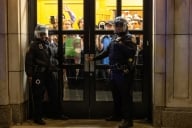You have /5 articles left.
Sign up for a free account or log in.

Shendart/Istock/Getty Images Plus
During the course of my doctoral studies I have worked in two presidents’ offices and shadowed/observed the functions of the presidents and senior leadership teams at seven other colleges and universities for a week each. Through these experiences at institutions public and private, large and small, urban and rural, and selective to near open-access, there were many differences in the issues and experiences of senior leaders. There were also many similarities in the manner in which these leaders approached the issues and challenges they faced, even if the scope and scale of those issues differed by institution. Based on these experiences, I propose a set of key lessons that can be helpful to current and aspiring senior leaders alike.
Establishing a Clear and Realistic Vision
Although it seems obvious that each institution should have a vision and a strategy for achieving that vision, many institutions often struggle in articulating these ideas. A number of key points emerged through my visits about ways in which presidents attempt to effectively establish a clear and realistic vision.
- Be mission-centered. There are many types of institutions and each fits a different need. It can often be tempting to pursue prestige and climb various rankings lists, but that can often take an institution away from its core mission. As one president noted, it is important to be cognizant of the need to change and adjust to new circumstances, but also to stick to what an institution does best and build on those strengths.
- Limit the number of institutional priorities. For many institutions, a strategic planning process is vital to develop and execute a vision. It can also develop such a large number of goals, objectives and sub-objectives that one is left wondering if the institution has any priorities at all. At one institution, the executive team tried to tackle this common problem by establishing four to five university-level priorities each year, tied to the strategic plan but raised to a higher level of focus for the year. Another institution, in the midst of ending one strategic plan and starting a second, is consciously trying to have fewer goals in its new plan than in the first plan to keep the institution more focused. There is often no shortage of new ideas at colleges and universities and many are sound. However, institutions must guard against pursuing too many entrepreneurial ideas that sound good but stray too much from their mission and vision.
- Part of developing a realistic vision includes considering the resources necessary to achieve that vision. Institutions often require new budget requests to be linked to a particular part of a vision or strategic plan, but this does not address the question of how many resources in total are needed to fully implement such a plan. One institution I visited calculated the amount of resources it would take to implement each of the goals and objectives listed in its plan. The total was three times the university’s annual budget. This calculation helped the institution pare some of its goals to focus on a more realistic set of priorities.
Regular and Effective Communication
The challenges institutions face are often well-known (i.e., resource constraints, maintaining steady enrollment, improving graduation rates) and there is typically no shortage of ideas for tackling these issues. The challenge for many institutions and senior leaders is having the willingness and desire to select a course of action, stick to that action, and implement it effectively. The most common refrain I heard from senior leaders regarding the implementation of any major strategic action was the need for effective communication.
One institution I visited recently made significant changes to its tuition and fees structure. This institution’s leaders knew for a number of years that they wanted to make a change in this area. The challenge was not determining the right course of action, but determining how to implement it. In this instance it boiled down to effective and relentless communication. The proposed changes needed to be communicated to board members, government stakeholders, and key campus constituents. Only after multiple years of communicating the need for the change and explaining the proposal was the change able to be implemented. It did not take years to develop the proposal, but it took years of communication to build the necessary support for the proposal to be accepted and implemented.
In talking with institutional leaders about the histories of their campuses, it became clear that the presidents who were most successful in their roles were stronger communicators than those whose tenures were marred with controversy or ended prematurely. In those latter instances, it was not that a particular decision or set of decisions was wrong or ill-advised, but that those decisions were often not communicated effectively. Without taking the time to communicate with key constituency groups, particularly boards of trustees, leading up to and after a decision was made, actions were immediately viewed in a negative light. However, a strong communication effort can help turn opponents into supporters or at the very least ensure no one is blindsided by a decision.
Creating Time for Strategic Thought
It is often difficult for senior leaders to carve out time for strategic, long-term thinking in the midst of overseeing the day-to-day operations of a college or university. Yet reflecting on institutional priorities and thinking about long-term ideas is vital to the success of any senior leader. This is why a number of presidents have taken explicit steps to build time for strategy into their schedules.
One president regularly clears his schedule on Friday afternoons to reflect upon the activities of the week and prioritize the most important items to accomplish in the week ahead. Another president reserves time at every cabinet meeting to discuss a big-picture substantive issue such as improving student retention or increasing research funding. Cabinet meetings can often become dominated with updates and dealing with daily crises. By reserving time to discuss strategic issues, this president ensures that his team keeps the grand challenges the institution faces at the forefront of their minds.
Another way that several presidents have sought to maximize the use of their time is through restructuring their senior leadership teams. In doing so, many presidents sought to limit the number of their direct reports to a more manageable number. This helped the presidents reserve time that was typically used in meeting with direct reports to instead meet with key alumni, donors, government officials and other external stakeholders to promote their institutions.
There is no one best structure for organizing an executive team. What is important, however, is crafting a structure that the president is comfortable with and that allows the president to balance internal and external demands as well as balance day-to-day management activities with long-term strategic thinking.
Honest Feedback and Open Dialogue
Last, but certainly not least, is the need to develop a strong senior leadership team and create a culture of open dialogue and honest feedback. As one president indicated, trust is the currency of the job, and this requires developing a team of vice presidents and executives who will be honest and open both with the president and with each other. This often begins directly at the top. Presidents should be comfortable with not having all the answers. They should recognize what they do not know and surround themselves with a capable team that can fill those gaps in knowledge.
Once a strong team is formed, it is important that the team is utilized to its full potential. As one leader noted, it is important to suspend your desire to have your predetermined outcomes “win.” This means not calling meetings where answers have already been determined and proactively seeking alternative viewpoints. One of the greatest frustrations presidents expressed was the difficulty in receiving honest feedback and that individuals often try to tell them what they think the president wants to hear.
A number of presidents guard against this by sitting quietly through meetings, sometimes speaking up at the end, but other times never revealing their thoughts on an issue. These presidents typically had clear opinions on the issues discussed, but wanted to hold an initial meeting on a topic without revealing their own bias that would inevitably dominate discussion within the group.
Holding a senior leadership position at colleges and universities is a complex and challenging job. My view of these positions has been from an observer’s role. However, the opportunity to observe and compare leadership teams at nine institutions and have candid conversations with dozens of executives at each institution has provided a window for understanding some of the challenges senior leaders face in executing their duties as well as strategies for addressing these issues.
Each institution may face its own set of substantive challenges that require distinctive approaches, but many institutions face common leadership challenges. These lessons may help address these challenges and serve as a guide for aspiring leaders as they rise through the administrative ranks.








